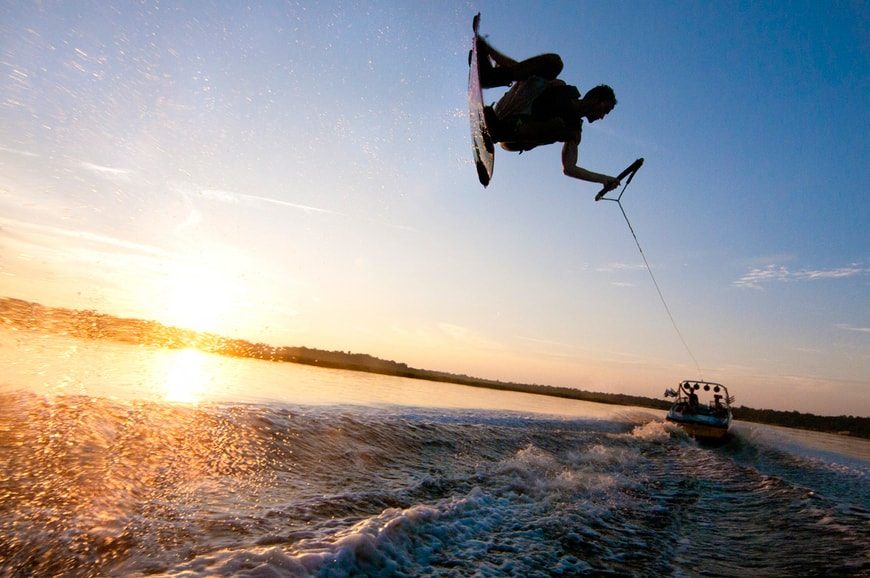If you want to understand the wakeboarding sport better, then there are a few different wakeboard glossary terms that you are going to need to be aware of. Wakeboarding is a truly specialized sport, and the terms that are attached to this sport are also quite specialized. If you are not already aware of the terms that matter the most in wakeboarding, then you could find yourself facing trouble in the future. Try to get yourself familiar with these popular wakeboarding terms as soon as you possibly can, because this is going to help you out immensely when it comes to communicating your needs, your capabilities and your desires while participating in this unique and exciting sport. These terms are going to be regularly used in the process of wakeboarding, and if you do not have the proper knowledge then you are going to be unable to properly convey your messages when communicating with other wake boarders. Why participate in a sport if you are not willing to learn the language?
Here are some of the more important terms that you are going to want to know when it comes to effectively wakeboarding.
Double Up – Sometimes the boat that is pulling the wakeboard is capable of circling around and then crossing back over the wake that it just finished creating. This occurs at approximately 90 degrees, and it causes the wakes to come together or converge, which in turn results in wakes that are double their normal size. What this is known as is a double up. If the rider has the right timing when this is happening, then he or she will be able to get much more air during a double up situation than in any other situation on the water.
Ballast – When extra weight is added to the boat pulling the wakeboard, then this is known as ballast. Fitting large and heavy sacks or adding additional people to the boat is naturally going to make the boat much heavier, and this is known as a ballast. The purpose for this particular action is to help the boat be capable of causing more wakes, or causing more intense wakes. There are some boats that are specifically retrofitted with ballast systems, which are designed to fill with water, making the boat naturally heavier rather than artificially heavier, in order to create a better wake boarding experience.
Butt Check – The butt check is a specific type of position used in wakeboarding. In order for this particular position to be carried out, the wakeboard rider will lean back so that his or her bottom is touching the water, with feet out in front and arms held out straight. The purpose of this position is to keep the wakeboard rider from crashing.
Lip – The top of the wake that you are riding on as a wake boarder is known as the “lip” of the wake, or the wake’s lip.
Face Plant – The face plant is a specific type of fall. The way that a face plant fall occurs is that you fall, catching your toe-side edge, and this ultimately results in you falling very quickly face forward until you go into the water face first or head first. This is generally not a good way to fall, and should be avoided because it can be extremely uncomfortable.
Bail – Upon realizing that you will be unable to complete a trick, the act of bailing has to do with giving up on the trick rather than attempting to execute it. There are definitely going to be times where a trick is not going to end up the way that you had assumed it would, or that you wanted it to happen. You may fail at a trick because you took too much air, for example, or you may fail at your trick because you lost control. Either way, sometimes bailing out of the trick becomes necessary just to make sure that you do not end up face planting.
Fakie – The term Fakie is used in order to describe a wakeboarding situation, where you are wakeboarding off of the boat in the standard riding position, but you are traveling in the opposite direction instead. This is not commonly done, simply because what is requires is that you make a change in the position of your foot. The fakie term has also been popularly replaced by another term, which is Switch stance. The switch stance term is essentially referring to a situation where the person is riding the wakeboard with their opposite foot in the forward position.
White Wash – This is the turbulent water that is found to be present in the dead center of two converging wakes. The wake itself is capable of containing whitewash, making it difficult for the wake to have hit.
Lube – This is any substance that is slippery, but when it comes to wakeboarding, lube is used to assist you in getting your feet into your bindings. There are lubes that are specifically made for this purpose, but some people simply use materials such as soap, shaving cream and Vaseline to serve as alternative lubes.

